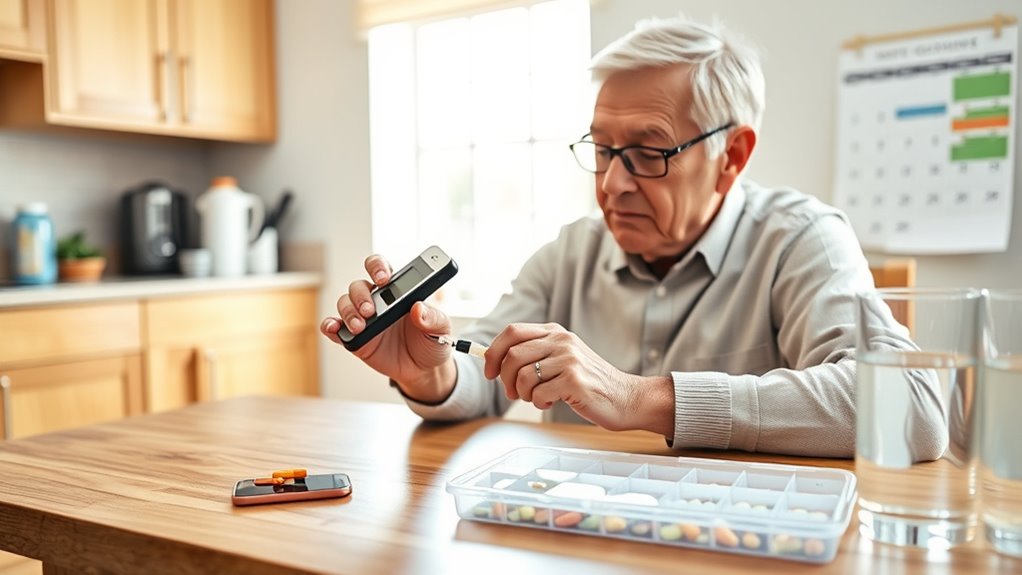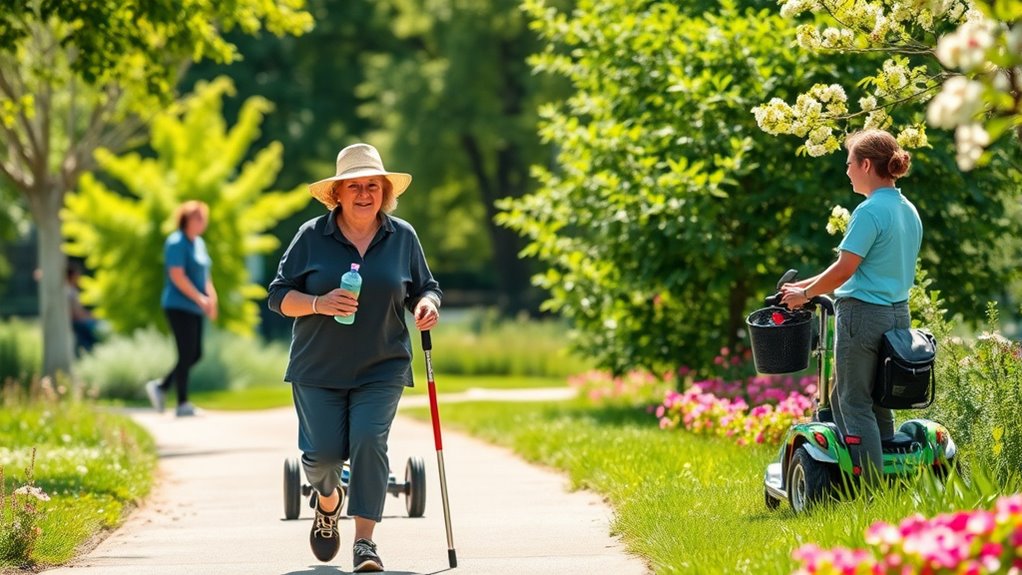To manage diabetes effectively as an older adult, focus on personalized blood sugar targets that suit your overall health, and simplify your medication routines with regular reviews and easy-to-use monitoring tools. Incorporate balanced nutrition, physical activity suited to your ability, and address any other health conditions carefully to minimize medication risks. Proper skin and foot care, along with support from technology and caregivers, can also make a difference. Keep exploring strategies to improve your quality of life beyond basic tips.
Key Takeaways
- Individualized blood sugar targets consider age, health, and hypoglycemia risk to optimize safety and prevent complications.
- Nutritional adjustments, including fiber-rich foods and limiting processed sugars, help stabilize blood glucose levels.
- Regular medication reviews and simplified regimens reduce polypharmacy risks and improve adherence.
- Incorporating tailored physical activities and monitoring techniques enhances safety and supports better glycemic control.
- Proper foot, skin, and daily routine care prevent injuries and infections, crucial for elderly diabetes management.
Tailoring Blood Sugar Targets for Older Adults

Because older adults often have unique health considerations, it’s important to tailor blood sugar targets to their individual needs. Personalized target setting allows you and your healthcare team to establish goals that consider your overall health, risk of hypoglycemia, and life expectancy. Age-specific goals help prevent complications while minimizing treatment side effects. For some seniors, a slightly higher blood sugar target may reduce the risk of falls or dizziness, especially if they have other health conditions. Conversely, healthier older adults might aim for tighter control. By customizing these targets, you’re better equipped to manage diabetes effectively while maintaining quality of life. Understanding age-related health factors can further refine treatment goals and improve outcomes. Recognizing comorbidities and their impact on blood sugar management is also essential for creating comprehensive and safe treatment plans. Incorporating cultural intelligence into patient education can enhance communication and adherence to management strategies. Additionally, considering individual health status helps ensure that treatment plans are both effective and safe, reducing the risk of adverse events. Always work closely with your healthcare provider to set realistic, achievable goals that suit your health status.
Simplifying Medication Regimens and Monitoring

Simplifying medication routines and monitoring can make managing diabetes easier and safer for older adults. Medication simplification involves reducing the number of daily doses or switching to combination medications, helping you stick to your plan. Monitoring approaches should be tailored to your needs, balancing accuracy with convenience. Consider these strategies:
- Using once-daily medications or long-acting insulins
- Incorporating easy-to-use glucose monitors
- Employing remote monitoring tools when possible
- Regularly reviewing your medication plan with your healthcare provider
- Understanding how vehicle tuning can optimize performance and safety, similar to how tailored diabetes management strategies improve treatment outcomes. Additionally, staying informed about Net+ Certification Benefits can empower you to better understand your health technology tools and improve your self-management skills. Engaging with air purifier features can also help create a healthier environment that supports overall well-being. Keeping track of your health data with digital health records can further enhance your monitoring effectiveness. Furthermore, choosing user-friendly devices can reduce confusion and support consistent use, making daily management even more manageable.
These approaches can decrease the risk of errors, improve adherence, and make daily management less burdensome. By streamlining your medication regimen and adopting suitable monitoring methods, you enhance safety and maintain better control of your blood sugar levels.
Incorporating Nutritional Adjustments for Better Control

Adjusting your diet can considerably improve blood sugar control and overall health. Nutritional counseling and careful dietary planning help you make smarter food choices. Focus on balancing carbs, proteins, and fats to stabilize blood sugar levels. Incorporate more fiber-rich foods like vegetables and whole grains, which slow sugar absorption. Limit processed foods and sugary drinks that cause spikes. Partner with a dietitian to tailor a plan suited to your needs, preferences, and medication. Remember, small changes lead to big improvements. Use this emotional table to guide your journey:
| Emotional Aspect | Dietary Strategy |
|---|---|
| Confidence | Trust your plan |
| Comfort | Enjoy your foods |
| Motivation | Celebrate progress |
| Empowerment | Take control |
| Hope | Better health awaits |
Additionally, understanding the cost of electric bikes can motivate you to incorporate active transportation into your routine, contributing to improved physical health and blood sugar management. Being aware of signs of spoilage in lemon juice can help you choose fresh ingredients for healthier meals, while also considering privacy and cookie usage to better understand online resources related to nutrition. Recognizing the importance of using the appropriate headphone jacks can enhance your experience when listening to educational content or music that supports your health journey.
Promoting Physical Activity Suitable for Age and Ability

Building on your efforts to improve nutrition, incorporating appropriate physical activity can further enhance blood sugar control and overall well-being. You don’t need intense workouts—simple, age- and ability-appropriate exercises make a difference. Consider chair exercises to improve flexibility and strength without stressing joints. Walking routines, even short daily walks, boost cardiovascular health and help regulate blood sugar levels. To keep things engaging, try:
- Gentle stretching or chair yoga
- Short, brisk walks around the block
- Light resistance exercises using household items
- Balance and posture exercises to prevent falls
These activities are easy to adapt to your energy level and mobility. Additionally, early detection of symptoms can lead to prompt management and prevent complications. Incorporating visualization techniques can also motivate you to stay consistent with your routines. Research shows that regular physical activity can significantly improve blood glucose levels and overall health outcomes. Understanding the role of psychological factors, such as motivation and self-efficacy, can support sustained engagement in exercise routines. Consistency is key, and always listen to your body—stop if you feel discomfort. Incorporating these routines can make a meaningful difference in managing diabetes effectively. Diverse exercise options can also help prevent boredom and promote sustained engagement.
Managing Comorbidities and Reducing Polypharmacy Risks

You need to coordinate care effectively to manage multiple health conditions and prevent medication overload. Optimizing medications guarantees each one provides clear benefits without unnecessary risks. By focusing on these strategies, you can improve safety and quality of life for elderly patients with diabetes. Incorporating medication review protocols regularly can help identify unnecessary medications and reduce polypharmacy. Additionally, fostering a creative practice mindset in care planning can encourage innovative solutions to complex medication challenges. Regularly reviewing support hours and available resources can also help ensure timely assistance and guidance in managing complex medication regimens. Furthermore, integrating appliance maintenance plans into routine care can help prevent adverse events related to medication storage and administration. Emphasizing mental clarity and hydration can also support cognitive health, which is crucial in managing complex treatment plans for the elderly.
Coordinated Care Approaches
Managing multiple health conditions in elderly diabetes patients requires a coordinated care approach that guarantees all aspects of their health are addressed simultaneously. You can achieve this by collaborating with healthcare providers to develop thorough plans, focusing on minimizing medication conflicts, and integrating mental health support. Leveraging community resources helps ensure access to essential services, social support, and education. Key strategies include:
- Regular communication among primary care, specialists, and mental health providers
- Utilizing integrated mental health services to address emotional and psychological needs
- Connecting patients with community resources for nutrition, exercise, and social engagement
- Monitoring for polypharmacy risks to prevent adverse drug interactions
Medication Optimization Strategies
Effective medication management is essential for elderly diabetes patients who often juggle multiple health conditions. You should regularly review your medications to prevent polypharmacy risks, ensuring each drug is necessary and appropriate. Optimizing insulin timing helps maintain blood glucose control and reduces hypoglycemia. To improve medication adherence, consider simplifying your regimen and using reminders. The table below highlights key strategies:
| Strategy | Action | Benefit |
|---|---|---|
| Regular Review | Consult your healthcare provider | Minimize drug interactions |
| Simplify Regimen | Use combination pills or dosing schedules | Enhance adherence |
| Monitor Insulin Timing | Coordinate with meals and activity | Achieve stable glucose levels |
| Educate Yourself | Understand medication purpose | Improve compliance |
| Address Side Effects | Report issues promptly | Reduce unnecessary medication adjustments |
Additionally, staying informed about medication side effects can help you recognize and address issues early, further supporting your health management. Regular education about medication management empowers you to make informed decisions and enhances overall safety.
Enhancing Cognitive Support and Education

You can support cognitive health by encouraging activities that keep the mind engaged and sharp. Using tailored education methods helps guarantee that information about diabetes management is clear and easy to understand. By customizing your approach, you make it easier for elderly patients to stay informed and confident in their care.
Cognitive Health Promotion
How can we best support cognitive health in elderly individuals with diabetes? You can boost their mental clarity by encouraging activities like memory exercises and social engagement. These practices stimulate brain function and help maintain cognitive abilities. Consider incorporating simple memory games or puzzles into daily routines. Promoting regular social interactions reduces feelings of isolation, which benefits cognition. You might suggest joining community groups or participating in group activities. Additionally, educate about the importance of staying mentally active to delay cognitive decline. Small consistent efforts can make a significant difference. By focusing on engaging the mind and fostering connections, you empower elderly individuals to maintain independence and improve overall quality of life. These strategies serve as a essential part of thorough diabetes management.
Tailored Education Methods
Tailored education methods play a crucial role in helping elderly individuals with diabetes better understand their condition and manage it effectively. Using motivational interviewing, you can encourage open dialogue, helping you explore your beliefs and motivations around diabetes management. This personalized approach boosts your confidence and commitment to healthy behaviors. Visual aids also enhance learning by simplifying complex information, making it easier to grasp important concepts like blood sugar monitoring and medication use. By combining motivational interviewing with visual tools, your healthcare provider can customize education to suit your learning style and cognitive needs. This targeted approach ensures you receive relevant, understandable information, empowering you to take an active role in managing your diabetes confidently and effectively.
Addressing Skin Care and Foot Health to Prevent Complications

Since the skin and feet are especially vulnerable to complications from diabetes, maintaining proper skin care and foot health is essential for elderly individuals. Protecting skin integrity prevents infections and sores that can worsen quickly. Regular foot care helps identify issues early and reduces the risk of ulcers or amputations. To keep your skin and feet healthy, consider these tips:
- Check daily for cuts, blisters, or redness
- Keep feet clean and moisturized, avoiding between toes
- Wear well-fitting, supportive shoes
- Avoid walking barefoot to prevent injury
Leveraging Technology for Better Diabetes Management

Using technology can considerably enhance your ability to manage diabetes effectively. Wearable sensors allow you to continuously monitor blood glucose levels without frequent finger pricks, giving you real-time data to make informed decisions. These devices often sync with your smartphone, making it easier to track trends and adjust your habits. Telehealth appointments provide convenient access to your healthcare provider, so you can discuss concerns and review your progress without leaving home. This technology helps you stay engaged with your diabetes management plan and respond quickly to fluctuations. By integrating wearable sensors and telehealth into your routine, you gain better control, reduce complications, and feel more empowered in managing your health. Embracing these tools can make your diabetes journey more manageable and less stressful.
Fostering Support Systems and Caregiver Involvement

Fostering strong support systems and involving caregivers are essential components of effective diabetes management for seniors. Engaged community networks provide emotional resilience, reducing feelings of isolation and encouraging adherence to treatment plans. When caregivers are actively involved, you benefit from consistent monitoring, timely adjustments, and emotional encouragement. Consider how community engagement can:
- Connect you with local support groups
- Offer educational resources to caregivers
- Facilitate peer sharing of experiences
- Promote a sense of belonging and understanding
Frequently Asked Questions
How Can I Motivate Elderly Loved Ones to Stick With Their Diabetes Plan?
You can motivate your elderly loved ones by using motivational interviewing techniques, which help them find personal reasons to stay committed to their plan. Involve family members in their care, providing support and encouragement. Listen actively, respect their feelings, and celebrate small successes. This approach boosts their confidence, makes them feel understood, and increases their motivation to stick with their diabetes management plan.
Are There Specific Signs of Hypoglycemia to Watch for in Seniors?
You should watch for signs of hypoglycemia in seniors, like sudden sweating, shakiness, or confusion. Low blood sugar can also cause dizziness, weakness, or irritability. If you notice these symptoms, check their blood sugar levels immediately. Prompt action is essential to prevent serious complications. Always keep quick sources of sugar nearby, and consult their healthcare provider for personalized advice on managing and recognizing hypoglycemia symptoms.
What Are Safe Exercise Options for Elderly Adults With Mobility Issues?
Imagine gentle waves guiding you to calmer shores. You can do chair exercises that feel like a soft breeze supporting your movements, helping you stay active without strain. Aquatic therapy acts like a soothing stream, reducing joint stress while boosting strength and flexibility. These safe options let you stay mobile and engaged, turning exercise into a invigorating, manageable part of your daily routine despite mobility challenges.
How Do I Handle Diabetes Management During Unexpected Health Events?
When unexpected health events occur, you should prioritize emergency preparedness by keeping a list of medications, emergency contacts, and medical history accessible. Make sure to monitor your blood sugar levels regularly, and if necessary, adjust your medications under your healthcare provider’s guidance. Stay calm, hydrate, and seek medical help promptly if symptoms worsen. Proper planning helps you manage diabetes effectively during emergencies, ensuring your safety and health.
What Community Resources Are Available for Elderly Diabetes Support?
You can find valuable community resources for support by exploring local support groups and community health programs. These groups offer emotional encouragement, shared experiences, and practical advice, helping you manage diabetes more effectively. Reach out to your local health departments or hospitals to discover programs tailored for seniors. Joining these resources keeps you connected, informed, and motivated, making it easier to maintain your health and navigate challenges associated with diabetes.
Conclusion
Managing diabetes in older adults can seem overwhelming, but with tailored goals, simple routines, and support, you can stay in control. Imagine a clear path: setting realistic blood sugar targets, enjoying easy meal tweaks, and staying active suited to your abilities. By embracing technology and involving loved ones, you create a safety net. It’s not about perfection, but progress—making everyday management manageable and empowering you to live healthier and happier.








